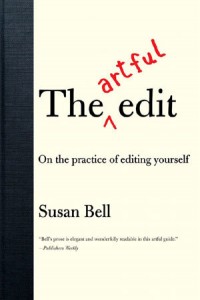Editing as Creative as Writing
Bell, Susan (2007). The Artful Edit: On the Practice of Editing Yourself. New York: W.W. Norton.
Bell has been a book editor for decades and in this well-written and well-edited volume, provides instruction and explanation about the art of editing, for writers who want (need) to edit their own manuscripts, and that would include all writers.
She starts with the big picture, how to evaluate whether your story hangs together, whether you have a structure that works, whether your manuscript accomplishes what you had intended for it. She also covers micro-editing, or line-editing, with emphasis on selecting the right words, cutting redundancies, and revising for rhythm and sonority. Many of these techniques and admonitions are well-known to writers but it is helpful nonetheless to have them reviewed so articulately.
There are several features that make the book uniquely valuable however, chief among them, its ongoing discussion of editor Max Perkins’ work with F. Scott Fitzgerald in creating The Great Gatsby. There is a summary of that iconic novel, then specific examples, both at the macro and micro levels of edit, of how Fitzgerald revised the manuscript under Perkins’ guidance. Many before and after passages are given and these are extremely illuminating. Similar examples are given for other writers, from John Hawkes to John O’Hara, but the Fitzgerald examples are best.
There are also exercises and checklists at the end of chapters that writers can use in evaluating their own work, and these actually seem useful, unlike the typical brain-dead homework offered in many instructional writing books. At the end of chapters we also find several paragraphs of comments and advice about self-editing, from writers such as Tracy Kidder, Michael Ondaatje and Ann Patchett. These are quite illuminating.
But wait, there’s more! Bell also provides some expositional material on the practice and profession of editing, including a history, consideration of how editors (other than oneself) can be helpful or harmful, and some fascinating reports on self-editing from a photographer and a cinema sound editor. The message seems to be that all artistic products need to be edited and the process is fundamentally creative in nature, regardless of medium.
Unfortunately, the book is not indexed, limiting its value for reference, but there is a good bibliography. I benefited most from the discussion of Gatsby, but the book’s many other features are worthwhile. The biggest problem in self-editing, it seems to me, is getting “distance” on the work. Bell offers some suggestions for accomplishing that, but it is still the biggest problem.
